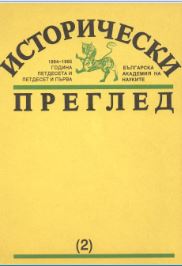Джелепите из централния и източния дял на Балканите през XVI в. – задължения, статут и социален състав (втора част)
The Celeps in the Central and Eastern Parts of the Balkans during the 16th c. – Obligations, Status and Social Structure (part 2)
Author(s): Elena Grozdanova, Stefan AndreevSubject(s): History, Economic history, Social history, Modern Age, Special Historiographies:, 16th Century, The Ottoman Empire
Published by: Институт за исторически изследвания - Българска академия на науките
Summary/Abstract: A most general definition would qualify the celeps (celepkeşans) as a category of the population with special obligations and status, as a numerous group of persons entrusted by the Ottoman authorities under certain conditions with the responsible task to supply as a sort of state order mainly with sheep and goats the big consumer centres of the Empire and the army. This study is devoted to this category of population during, if one may put it in this way, the classical period of its functioning, the 16th century, and specifically with reference to the Bulgarian lands and those bordering on them. Its aim is: 1. to follow up the specific obligations and status of the celepkeşans in the Central and Eastern parts of the Balkan Peninsula so as to compare them with the other similar categories of population with special obligations in the Ottoman State in the economic sphere (ore-miners, dairymen, salt-producers, etc.); 2. to subject to analysis the social composition of the celeps in the area indicated at that time with respect to their religious and ethnic belonging, property status, some other economic activity exercised by them at the same time, the mass presence of persons in orders, etc. For this purpose, besides the already published documents, have been traced and used many newly discovered and unpublished yet Ottoman Turkish documents, mainly from the Oriental Department of the “Sts Cyril and Methodius” National Library in Sofia, the Historical Archives for Macedonia in Salonika, the Oriental Collections of the State Archives in Budapest, some archives in Turkey, etc. In the course of work were discovered and corrected also a number of errors and inaccuracies allowed in the publication of some of the registers of the celepkeşans of the 16th c. The most interesting data are extracted and arranged in special tables. It has been established that during the 16th c. in the Bulgarian and contiguous lands the registered celeps formed the most numerous category of population with special obligations and status in the economic sphere. Their social composition during the second half of the 16th c. was very variegated in a wide range. They included Christians, Muslims and Jews, a settled population and nomads, peasants and town dwellers, merchants, artisans and soldiers. Village and town priests lived in the ranks of the celeps together with imams and dervishes, and spahis and heads of vakifs – with prisoners of war and slaves. The nature of their obligations also determined the principal requirements to the celeps: to be physically fit, materially stable and solvent. On the basis of partly direct and partly indirect data, the peculiarities in the status of the celepkeşans are outlined as follows: in exchange for their obligation to supply for the needs of the State from 20–25 to 300 head of sheep and goats annually, they were exempted from extra taxes and state charges although they paid in the general way the adeti agnam tax on sheep; under the law they were not to be burdened with some other kinds of services in favour of the State outside the celepkeşan one, but they frequently combined it with different occupation exercised in parallel, over 120 of which are listed in the registers to which we have access; they enjoyed greater freedom of movement and according to some official ordinances even those subject to taxation among them were not regarded as raya. The hereditary nature of the celepkeşan obligations is also followed up; as a rule they were handed down from fathers to sons, brothers and grandsons. Unlike the voynuks – another well-known category of the population with special duties and status but in the military-auxiliary and not in the economic sphere, along with the celepkeşans were not registered in advance in an independent list their “reserves” as were, for instance, for the voynuks the category “zevaid-i voynugan”. Here again, with the celepkeşans, continuity proved to be of particular importance. It was connected with economic experience accumulated in the course of centuries, established commercial relations and repeatedly tested roads which made it possible for a celep not only to survive while fulfilling his obligations but also to get rich. In this sense it seems regular that many of the most prominent Bulgarian celeps and beglikijis of the 19th c. originated from families with centuries long presence in this kind of economic activity of particular importance.
Journal: Исторически преглед
- Issue Year: 1995
- Issue No: 2
- Page Range: 23-58
- Page Count: 36
- Language: Bulgarian
- Content File-PDF

